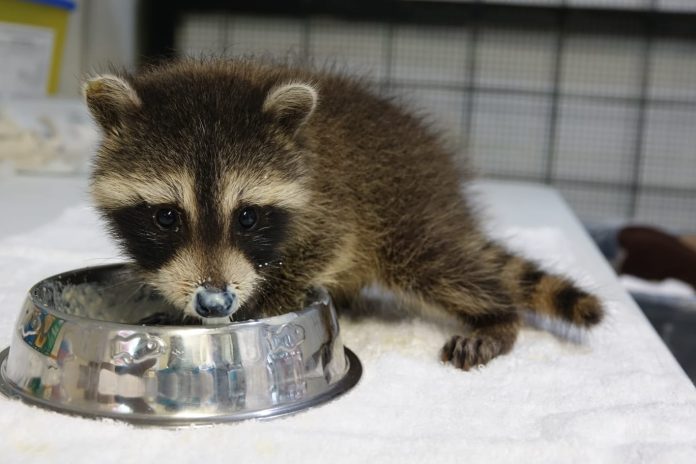Aspen Valley Wildlife Sanctuary is one of eight Ontario-based wildlife centres sounding the alarm over the growing number of orphaned wildlife in the region.
As temperatures rise, wildlife activity increases and many species, including raccoons and squirrels seek warm, secluded spaces to nest and raise their young. Attics, chimneys, and other quiet undisturbed areas become prime spots for these animals.
Not only is this an issue for homeowners, it is also of deep concern for wildlife rehabilitation centres who are on the receiving end of the hundreds of baby animals who are orphaned every year when homeowners evict their moms from their premises.
“If the orphaned animals are found quickly enough, they can be taken to a wildlife rehabilitation centre for care and eventual release.” said Janalene Kingshott, Director of Animal Welfare at Aspen Valley Wildlife Sanctuary. “However, wildlife rehabilitation centres throughout Ontario are reaching their maximum capacity as soon as May, and the calls keep coming for several months thereafter.” This means rehabbers need to make the heart-breaking decision to turn away hundreds of baby animals each year.
This tragedy is not only devastating but entirely preventable. In response, eight leading Ontario-based wildlife centres, including Aspen Valley, have united in a powerful effort to raise awareness and educate homeowners on more responsible and effective ways to deal with wildlife on their property.
“All wildlife plays an important role within the ecosystem, added Kingshott. “Together, we are encouraging the public to view wild animals with compassion and understanding —ensuring baby animals are not orphaned in the process.”
The Problem with Trapping and Relocation
While the majority of individuals can grasp the barbaric nature of a kill trap, many people remain under the wrongful impression that live traps are a humane option. This is simply not the case. Live-trapped animals experience significant stress, often injuring themselves in attempts to escape the trap. They are also vulnerable to extreme temperatures and dehydration while waiting to be transported to another location. Some never make it.
If released, these animals face even more challenges. Often ripped away from their young, they are left in an unfamiliar environment struggling to find food and shelter. They may also encounter territorial disputes with other wildlife, adding more stress to an already traumatic experience.
To minimize the risks to survival and limit the potential for disease transmission, Ontario’s Fish and Wildlife Conservation Act prohibits the relocation of animals more than one kilometre from their capture site. While this is intended to protect animals, ecosystems and humans, it is not foolproof. In fact, many species have incredibly strong homing instincts and will likely return to their original territory, including to their young. As a result, legal relocation is frequently ineffective.
A More Humane Approach
With these challenges in mind, it’s important for homeowners to take a more humane and thoughtful approach to managing wild animals on their property.
Following are best practices supported by wildlife centres across the province.
1. The Gift of Time
If you are aware that the wildlife in your home has babies, the most humane approach is to allow her time to care for them until they are old enough to follow her out of the den on their own (typically around 8-10 weeks old). This prevents orphaning the babies and gives them the best chance at survival. Important Note: Before sealing any entry points ensure all babies have left. One way to determine this is to place a crumpled paper towel at the entrance to track movement. If the paper towel is disturbed, it likely means that an animal is still inside.
2. Discourage Occupancy
To encourage wild animals to leave on their own, experts recommend making the den area less than ideal for a nursing mom by incorporating various elements in or near the den, such as:
- Leaving a talk radio station playing (no music).
- Using a non-flammable light source in or near the den area.
- Introducing strong smells, like apple cider vinegar on rags placed in a plastic bag with holes.
Using all three methods together, with patience, will likely encourage the mother to move her babies to a new den. Since the majority of species have multiple den sites nearby, the transition can occur smoothly for both human and animal families.
If you’d like guidance on this process, contact Aspen Valley’s animal care line at 705-644-4122. You can also visit www.aspenvalley.ca for additional information on living in harmony with wildlife.
3. Seek Professional Help if Necessary
If the situation becomes overwhelming, seek a reputable wildlife control company with expertise in wildlife biology and behaviour, especially during mating and breeding seasons.
Their service should include:
- A thorough inspection and free estimate.
- Identifying entry points and locating the mother and her babies.
- Using humane techniques, like one-way doors to allow the mother to leave on her own.
- Gently removing the babies and placing them in a heated reunion box, where they can stay warm until the mother returns and takes her babies one by one to another safe den site.
- After the removal, and reuniting the animal family, the company should secure all entry points to prevent future stays and repair any damage caused by the animal.
We do not recommend companies that offer to “live trap” and “relocate” the animal.
4. Wildlife Proof Your Home
To reduce the risk of future wild guests, homeowners should take proactive steps to wildlife-proof their homes. Basic steps would include:
- Removing food sources, such as securing trash bags and storing them in secure bins.
- Sealing entry points, including the installation of chimney and vent covers.
The Wildlife Centres Involved in this Initiative
The eight organizations involved in this effort include:
- Aspen Valley Wildlife Sanctuary (Rosseau, Ontario)
- Hollys Haven Wildlife Rescue (Dunrobin, Ontario)
- Procyon Wildlife (Beeton, Ontario)
- Sandy Pines Wildlife Centre (Napanee, Ontario)
- Shades of Hope Wildlife Refuge (Pefferlaw, Ontario)
- Speaking of Wildlife (Orillia and Area, Ontario)
- Turtle Pond Wildlife Centre (Val Caron, Ontario)
- Woodlands Wildlife Sanctuary (Minden, Ontario)








